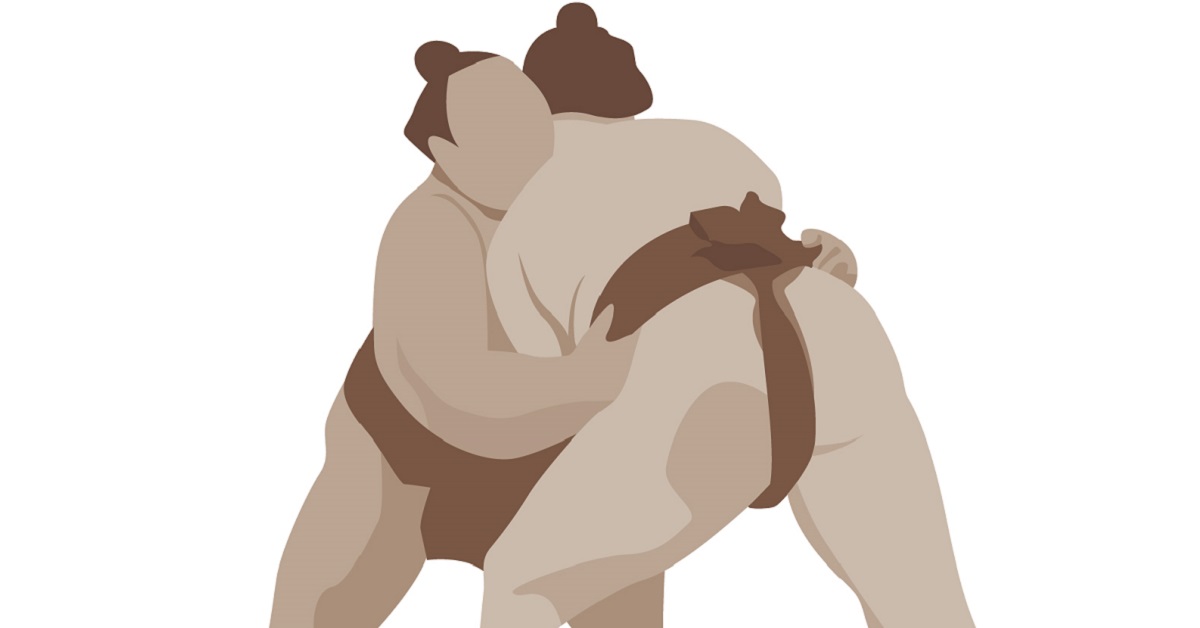Buchikamashi is not just a collision, but a powerful symbol of a sumo wrestler’s technique, strategy, and spirit. For anyone looking to understand sumo on a deeper level, grasping the meaning of this move is a vital first step.
What is Buchikamashi?
Buchikamashi is one of the most visually explosive moves seen at the start of a sumo bout. Wrestlers use their full body weight to crash into the opponent using their head or shoulder. Despite its simplicity, the move demands sharp judgment and precise technique.
Rather than just slamming into the opponent with brute force, the goal is to accurately target the opponent’s center of gravity and break their stance. This technique often favors larger wrestlers, who can use their mass to overpower the opponent from the get-go. However, if the movement is poorly timed or incorrectly executed, the wrestler risks injuring themselves, making technique just as important as power.
Furthermore, buchikamashi symbolizes the spirit of Japanese martial arts: confronting your opponent head-on with honor and courage. It is a fusion of strength, skill, and traditional values.
Purpose and Effects of Buchikamashi
The main goal of buchikamashi is to seize control of the match from the very beginning. By landing a powerful hit at the tachiai (initial charge), a wrestler disrupts their opponent’s balance and forces them into a defensive posture. This shift creates momentum and strategic advantage.
The move has several key effects:
| Effect Category | Description |
|---|---|
| Destabilizing Stance | Knocks the opponent back and breaks their form |
| Psychological Pressure | Intimidates and overwhelms with force |
| Technique Transition | Opens opportunities for follow-up attacks like pushing or throwing |
| Confidence Boost | Establishes control, increasing mental dominance |
These advantages make buchikamashi more than just a physical collision. It is a strategic tool used to direct the match’s flow, valued and refined through rigorous practice.
Buchikamashi and Safety: Risks and Countermeasures
While buchikamashi is a powerful technique, it carries significant physical risks. Since wrestlers lead with the head or shoulder, it can cause severe damage to the brain, neck, or spine. There have been real cases of concussions or career-ending injuries resulting from excessive or poorly executed buchikamashi.
Here are the primary dangers:
| Risk | Details |
|---|---|
| Brain Trauma | Can result in concussions and long-term neurological effects |
| Neck Injury | Excess pressure on the cervical spine can cause serious damage |
| Chronic Injury | Repeated collisions stress the shoulders and back |
In response, the sumo world has introduced several safety initiatives:
| Measure | Details |
|---|---|
| Standardized Form | Emphasizing shoulder-first contact instead of head |
| Beginner Education | Training new wrestlers in proper technique and safe posture |
| Rule Review | Considering stricter rules to limit unsafe charges |
In modern sumo, there is a growing movement to balance tradition with safety, and buchikamashi is a central focus of this effort.
Notable Wrestlers Known for Buchikamashi
Throughout sumo history, several top wrestlers have successfully employed buchikamashi as a signature move. These athletes adapted the technique to their size, strategy, and style, turning it into a decisive weapon.
| Wrestler | Characteristics |
|---|---|
| Asashoryu | Famous for aggressive tachiai and swift wins using buchikamashi |
| Hakuho | Usually relied on skill, but unleashed powerful charges strategically |
| Kotooshu | Utilized height and weight to execute dominant frontal assaults |
| Kakuryu | Combined soft, technical sumo with occasional sharp buchikamashi |
What these wrestlers share is not just power, but the intentional use of buchikamashi as a tactical option, exploiting the moment to gain the upper hand.
Why Beginners and Foreigners Find Buchikamashi Fascinating
For sumo newcomers and international spectators, buchikamashi is the easiest and most thrilling move to understand. Watching two 150-kg athletes crash into each other with full force creates a sense of awe, even without understanding the rules.
The technique reflects the Japanese cultural ideal of “facing adversity with honor”. Wrestlers bow before battle, purify the ring with salt, and then collide with everything they have. This combination of ritual and violence leaves a lasting impression.
Foreign-born wrestlers have also embraced buchikamashi, modifying it to suit their own builds and speed. This incorporation of the move into international sumo styles highlights sumo’s evolution and global reach.
Training and Practice Behind Buchikamashi
Although it appears simple, buchikamashi requires precise control and muscle memory. Wrestlers undergo repeated drills to master the correct approach and timing.
Key training components include:
| Training Type | Objective |
|---|---|
| Ukemi (Falling) | Learning how to absorb impact and avoid injury |
| Core Strengthening | Ensures balance and control at the moment of collision |
| Timing Drills | Synchronizing movement with opponent’s start for maximum effect |
Through these practices, wrestlers gain the ability to execute powerful yet safe charges, turning buchikamashi into a refined technique rather than brute force.
Conclusion
Buchikamashi is not just a high-impact technique, but a symbolic and tactical expression of sumo’s essence. It combines strength, strategy, and the cultural values of directness and honor.
By understanding this technique, viewers gain insight into the depth of sumo as more than just a sport. Whether you’re a beginner or a foreign fan, buchikamashi provides an entry point to appreciate the full drama and discipline of sumo wrestling.





コメント